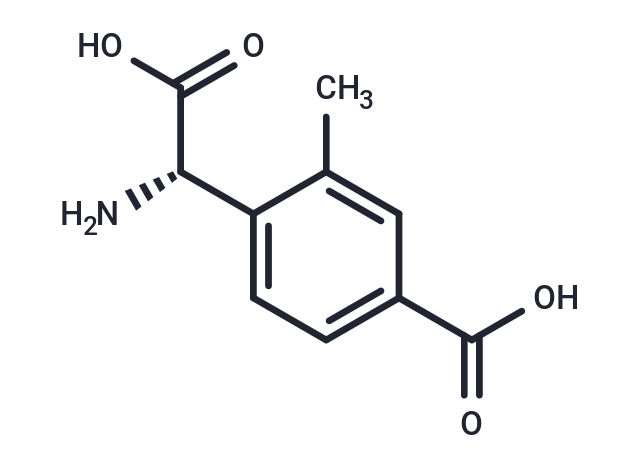Shopping Cart
- Remove All
 Your shopping cart is currently empty
Your shopping cart is currently empty

LY367385 is a highly effective and selective mGluR1a antagonist. LY367385 has neuroprotective, anticonvulsant, and antiepileptic effects. Compared with > 100 μM for mGlu5a, LY367385 has an IC50 of 8.8 μM for inhibits of quisqualate-induced phosphoinositide (PI) hydrolysis.

| Pack Size | Price | Availability | Quantity |
|---|---|---|---|
| 10 mg | $595 | 35 days | |
| 50 mg | $2,480 | 35 days |
| Description | LY367385 is a highly effective and selective mGluR1a antagonist. LY367385 has neuroprotective, anticonvulsant, and antiepileptic effects. Compared with > 100 μM for mGlu5a, LY367385 has an IC50 of 8.8 μM for inhibits of quisqualate-induced phosphoinositide (PI) hydrolysis. |
| Targets&IC50 | mGluR1a:8.8 μM |
| In vitro | LY367385 shows greater efficacy than LY367366 and neither of these compounds influenced neuronal viability per se and it also displays effective neuroprotective effects, causing a 50% reduction in (S)-3,5-Dihydroxyphenylglycine (DHPG) potentiation at a concentration of 10 nM. LY367385 combined with N-methyl-D-aspartate (NMDA) during the toxic pulse decreases neuronal degeneration in a concentration-dependent fashion, with a maximal reduction of NMDA toxicity ranging from 40 to 60%. LY367385 fully antagonized the amplification of NMDA toxicity by DHPG under experimental conditions at higher concentrations of the antagonist[2]. |
| In vivo | LY367385 effectively suppresses sound-induced clonic seizures in DBA/2 mice with a rapid onset, achieving a median effective dose (ED50) of 12 nM when administered intracerebroventricularly (i.c.v.) 5 minutes prior. It also significantly reduces the frequency of spontaneous electroencephalogram (EEG) spike and wave discharges in lethargic (lh/lh) mice, maintaining this effect from 30 to over 150 minutes post-administration at a concentration of 250 nM, i.c.v. Furthermore, LY367385 has been utilized in both DBA/2 and lethargic mice, in addition to direct application into the inferior colliculus of genetically epilepsy-prone rats (GEPR), demonstrating its efficacy in reducing seizures across different models. Specifically, in GEPR, a bilateral dose of 160 nM substantially mitigates clonic seizures within 2-4 hours. |
| Molecular Weight | 209.2 |
| Formula | C10H11NO4 |
| Cas No. | 198419-91-9 |
| Relative Density. | no data available |
| Storage | Powder: -20°C for 3 years | In solvent: -80°C for 1 year | Shipping with blue ice. |

Copyright © 2015-2024 TargetMol Chemicals Inc. All Rights Reserved.